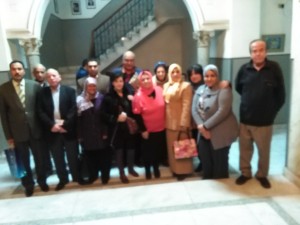Cairo Times 24 - 30 OCTOBER 2002
The Blue Aubergine - novel by Miral el-Tahawy
Reviewed by Richard Woffenden
Miral al-Tahawy's off-beat novel carries a mournful message
After the success of the translation of The Tent, which managed to reach and win over audiences in the US and Europe, English speakers have been looking forward to the translation of Miral al-Tahawy’s second, and most recent, novel The Blue Aubergine.
As part of the new fast track translation policy followed by the American University in Cairo over the last few years, successful new Arabic titles no longer wait up to ten years to be translated. The Blue Aubergine has been rendered into English just four years after the original hit the shops in Arabic.
Though it is only 123 pages long, Al Badhinjana Al Zarqa was no walk in the park for translator Anthony Calderbank. Like Iraqi novelist Alia Mamdouh, Miral al-Tahawy is an author whose Arabic language often leaves the reader in confusion and this of course is part of the appeal for many who love the ambiguities. However many readers, who had loved The Tent, found Al Badhinjana Al Zarqa quite hard going in Arabic, so to produce an accessible English translation was very difficult, for as well as the linguistic issues there are also many cultural issues that have to be explained to the foreign reader.
For the most part Calderbank succeeds–though it is not of the same caliber as the excellent translation that he did of Sonallah Ibrahim’s Zaat. Still, he successfully blends the poetry of the text alongside the prose to create an emotionally intense tale of a girl becoming a woman in the traumatic world that follows the 1967 defeat.
From the very start of The Blue Aubergine, the reader is plunged into a world that is populated with characters that have been distorted by the emotions of the protagonist, Nada, who is born into an Egypt at war with Israel. Her father is at the battlefront working as a doctor, so her world is one filled with women. We encounter the three grandmothers and her mother who is known to the reader as Queen Nariman (a reference to the wife of King Farouk). These women are portrayed predominantly through the eyes of the child, but without warning we are catapulted into the perspective of that child as a woman.
This shifting perspective complicates the novel in a way that reminds the reader of how we ourselves never really truly escape from our childhood perceptions of those who still surround as adults. Al-Tahawy uses this device to the fullest and in so doing creates an atmosphere less melodramatic than was the case in The Tent.
The relationship between mother and daughter is traumatic and one of the themes of the novel is the journey that Nada must go on before she can forgive the mother who tied her to the bedpost, who was embarrassed by her own child. As Nada fails to succeed in life and experiences rejection and isolation herself, she is slowly able to deal with the horrors of her childhood.
Her father is portrayed as a saintly university graduate. Nada is all too aware of how clichéd her idolization of her father and hatred of her mother is but struggles to understand how the emotions she felt affect her. Into this is added her brother Nader who is also driven to extremes by his family life. He becomes involved in the student political life with its communist and Islamist wings. Al-Tahawy brings to life a range of characters that create a vivid picture of campus life in the 1980s. Nada’s flatmate gets involved in destructive sexual relationships while Nada herself takes the veil and hides her face under the niqab.
As she becomes more and more isolated, Nada decides to remove her gloves and her veil and go to the other extreme, dressing in tight clothes and wearing her hair long. This transformation is subtly dealt with and is far from being the end of the novel as it could well have been. Nada’s future is far from rosy and more emotional disasters follow. These are all the more poignant as we are made to recall the child that we met at the start of the book, climbing trees, singing and dancing. As a backdrop, we are shown the image of Nada’s mother, empty and lost, a shadow of her former self, watching the petals falling to the ground as she sits alone.
The Blue Aubergine is a book best appreciated in one sitting. Constantly moving from past to present, from reality to fantasy, it is only when it is read in one session can it have a truly powerful impact. Trying to read it in spurts results in the reader’s flicking backwards to check this and that, whereas in one go, the novel flows over the reader and absorbs them. This is a challenging and intriguing novel and shows that al-Tahawy is set to be one of the freshest writers of her generation.




